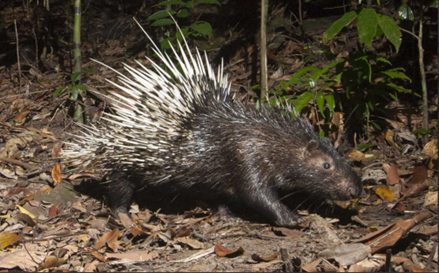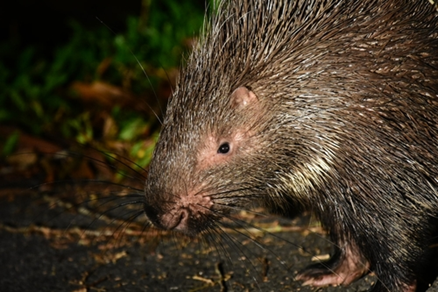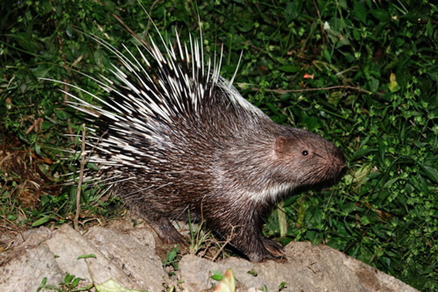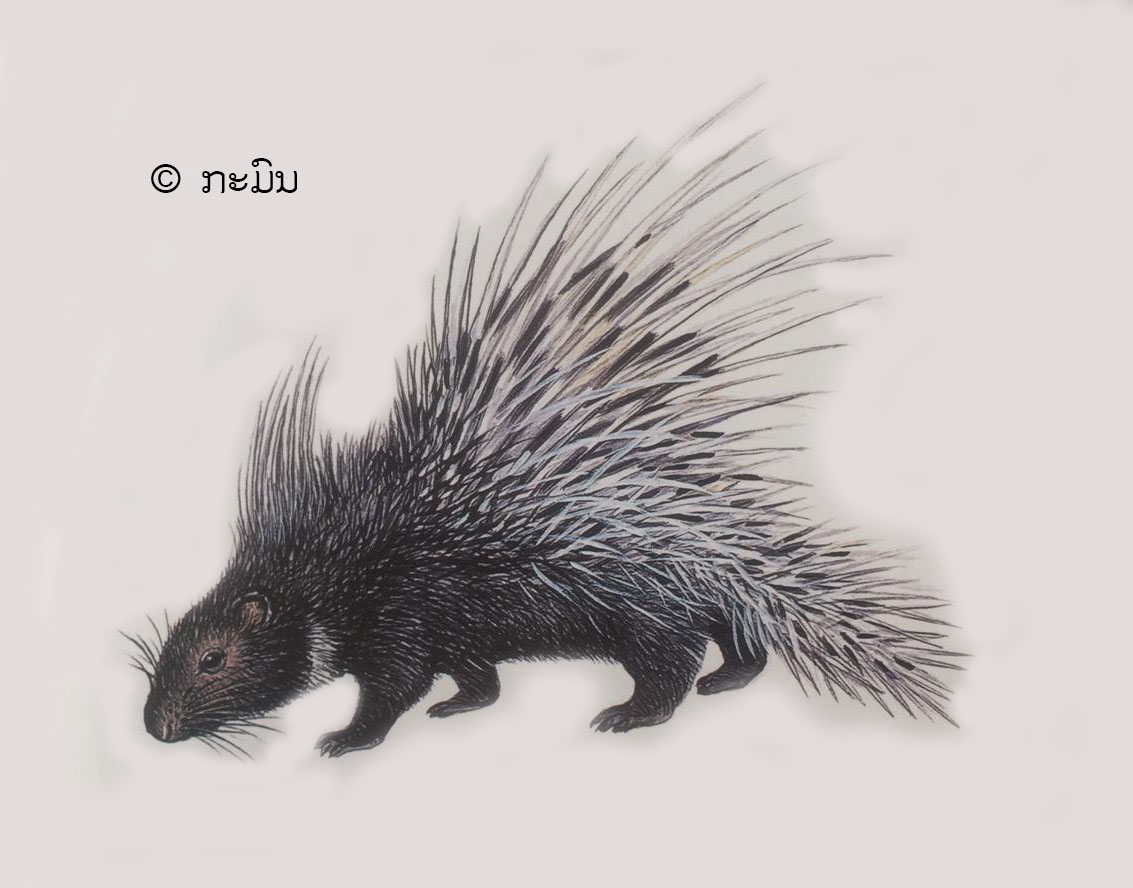ເລກລຳດັບທີ: 3639
ລະດັບການຮວບຮວມຂໍ້ມູນ: ຂໍ້ມູນພື້ນຖານ
ປັບປູງຄັ້ງລ່າສຸດ: 2014-10-19
ເໝັ້ນ
East Asian Pocupine
Hystrix brachyura Linnaeus, 1758
ສັດ
ສັດລ້ຽງລູກດ້ວຍນົມ
×
ຊື່ທ້ອງຖີ່ນ:
ເຣະ (ກຶມຸ) ( Himalayan Crestless Porcupine, Hodgson's Porcupine, Malayan Porcupine, Himalayan Porcupine)
ຊື່ພ້ອງ
:
Acanthion brachyurus (Linnaeus, 1758)
Hystrix hodgsoni
Hystrix hodgsoni
ຊື່ສະກຸນ:
Hystricidae
ຊະນິດໃກ້ຄຽງ:
ຫອນ/ Brush-tailed Porcupine
ບັນຍາຍລັກສະນະທາງພືດສາດ:
ເຫມັ້ນ - Porcupins: ຕະກຸນ Hystricidae
ເປັນສັດເລັມແຫ້ນທີ່ມີຕົນໂຕຂະໜາດໃຫຍ່ບຶກບຶນ, ປົກຄຸມດ້ວຍຂົນທີ່ມີການປ່ຽນແປງເປັນໜາມແຫຼມ, ມີກ້ານຂົນທີ່ແຂງມີຂາສັ້ນ, ເປັນສັດທີ່ກັງວົນຮູ້ສຶກສໍາພັດງ່າຍ, ໃນທົ່ວໂລກ: ມີຢູ່ 11 ຊະນິດ. ສະເພາະໃນ ສປປ ລາວ ມີຢູ່ 2 ຊະນິດ.1. ເຫມັ້ນ / Hystrix brachyura ຫົວ ແລະ ລໍາຕົວຍາວ: 63-72.5 ຊມ, ຫາງຍາວ: 6–11 ຊມ, ງ່າຍໃນການຈັດຈໍາແນກ ຄືສັດສ່ວນທາງຫຼັງມີຫາງສັ້ນໆ, ປົກຫຸ້ມດ້ວຍກ້ານຂົນໜາມ, ແຂງ, ຍາວທີ່ມີສີເຫຼືອງອ່ອນ ແລະ ມີສີຊ໋ອກໂກແລັດປົນນ້ຳຕານຢູ່ເປັນຈຸດໆເນີ້ງໄປທາງຫຼັງ, ຫົວມີຂົນສີນ້ຳຕານລຽບ ຕໍ່ຈາກນັ້ນທາງໜ້າກ່ອນເຄິ່ງລຳຕົວມີຂົນໜາມສີເຫຼືອງ ແລະ ມີຂາສັ້ນໆຫຸ້ມດ້ວຍສີນ້ຳຕານ. ອຸປະນິໄສ: ເປັນສັດຫາກິນກາງຄືນ, ເທິງດິນ, ອາໄສຢູ່ໃນຮູ ແລະ ມັກຈະເຮັດເສັ້ນທາງຮູໃຫ້ມີລັກສະນະເປັນຕາໜ່າງອ້ອມໆບໍລິເວນທີ່ຢູ່ອາໄສ. ພົບເຫັນຢູ່ທັງແບບໂດດດ່ຽວ ຫຼື ມີຄູ່, ກິນຮາກໄມ້ຫົວມັນ, ເປືອກໄມ້, ໝາກໄມ້ລົ່ນ ແລະ ທັງຊາກເສດທີ່ເໜົ່າເປື່ອຍຕ່າງໆ. ສຽງຮ້ອງ: ? ຖິ່ນອາໄສ: ພົບໃນປ່າທຸກຊະນິດທີ່ມີຄວາມສູງຈົນເຖິງ 1,760 ມ ໃນທົ່ວປະເທດ. ມັນສາມາດຄົງໂຕຢູ່ໃນສະພາບເຂດທີ່ມີການລ່າ.
ສະພາບການອະນຸລັກ: IUCN ຈັດວ່າເປັນສັດທີ່ຢູ່ໃນທ່າທີ່ອ່ອນໄຫວຕໍ່ການຖືກກະທົບໄດ້ງ່າຍ.
ເປັນສັດເລັມແຫ້ນທີ່ມີຕົນໂຕຂະໜາດໃຫຍ່ບຶກບຶນ, ປົກຄຸມດ້ວຍຂົນທີ່ມີການປ່ຽນແປງເປັນໜາມແຫຼມ, ມີກ້ານຂົນທີ່ແຂງມີຂາສັ້ນ, ເປັນສັດທີ່ກັງວົນຮູ້ສຶກສໍາພັດງ່າຍ, ໃນທົ່ວໂລກ: ມີຢູ່ 11 ຊະນິດ. ສະເພາະໃນ ສປປ ລາວ ມີຢູ່ 2 ຊະນິດ.1. ເຫມັ້ນ / Hystrix brachyura ຫົວ ແລະ ລໍາຕົວຍາວ: 63-72.5 ຊມ, ຫາງຍາວ: 6–11 ຊມ, ງ່າຍໃນການຈັດຈໍາແນກ ຄືສັດສ່ວນທາງຫຼັງມີຫາງສັ້ນໆ, ປົກຫຸ້ມດ້ວຍກ້ານຂົນໜາມ, ແຂງ, ຍາວທີ່ມີສີເຫຼືອງອ່ອນ ແລະ ມີສີຊ໋ອກໂກແລັດປົນນ້ຳຕານຢູ່ເປັນຈຸດໆເນີ້ງໄປທາງຫຼັງ, ຫົວມີຂົນສີນ້ຳຕານລຽບ ຕໍ່ຈາກນັ້ນທາງໜ້າກ່ອນເຄິ່ງລຳຕົວມີຂົນໜາມສີເຫຼືອງ ແລະ ມີຂາສັ້ນໆຫຸ້ມດ້ວຍສີນ້ຳຕານ. ອຸປະນິໄສ: ເປັນສັດຫາກິນກາງຄືນ, ເທິງດິນ, ອາໄສຢູ່ໃນຮູ ແລະ ມັກຈະເຮັດເສັ້ນທາງຮູໃຫ້ມີລັກສະນະເປັນຕາໜ່າງອ້ອມໆບໍລິເວນທີ່ຢູ່ອາໄສ. ພົບເຫັນຢູ່ທັງແບບໂດດດ່ຽວ ຫຼື ມີຄູ່, ກິນຮາກໄມ້ຫົວມັນ, ເປືອກໄມ້, ໝາກໄມ້ລົ່ນ ແລະ ທັງຊາກເສດທີ່ເໜົ່າເປື່ອຍຕ່າງໆ. ສຽງຮ້ອງ: ? ຖິ່ນອາໄສ: ພົບໃນປ່າທຸກຊະນິດທີ່ມີຄວາມສູງຈົນເຖິງ 1,760 ມ ໃນທົ່ວປະເທດ. ມັນສາມາດຄົງໂຕຢູ່ໃນສະພາບເຂດທີ່ມີການລ່າ.
ສະພາບການອະນຸລັກ: IUCN ຈັດວ່າເປັນສັດທີ່ຢູ່ໃນທ່າທີ່ອ່ອນໄຫວຕໍ່ການຖືກກະທົບໄດ້ງ່າຍ.
ນິເວດວິທະຍາ
ເຂດກະຈາຍພັນທົ່ວໂລກ:
Native to Bangladesh, China, India, Indonesia; Laos, Malaysia, Myanmar, Nepal, Thailand and Viet Nam
Source: [7]
Source: [7]
ເຂດກະຈາຍພັນໃນລາວ
:
ເຂດພູສູງພາກເໜືອຂອງລາວ
ເຂດພູສູງສາຍພູຫຼວງ ແລະ ເຂດພູພຽງແຂວງຊຽງຂວາງ
ເຂດສາຍພູຫຼວງພາກເໜືອ
ເຂດສາຍພູຫຼວງຕອນລຸ່ມ
ເຂດລຽບແມ່ນ້ຳຂອງພາກໃຕ້
ພູພຽງບໍລິເວນ
ເຂດພູສູງສາຍພູຫຼວງ ແລະ ເຂດພູພຽງແຂວງຊຽງຂວາງ
ເຂດສາຍພູຫຼວງພາກເໜືອ
ເຂດສາຍພູຫຼວງຕອນລຸ່ມ
ເຂດລຽບແມ່ນ້ຳຂອງພາກໃຕ້
ພູພຽງບໍລິເວນ

ເຂດກະຈາຍພັນຕາມພູມສັນຖານ
:
ປ່າດົງດິບ
ປ່າໂຄກ
ປ່າເຫຼົ່າແກ່
ປ່າໂຄກ
ປ່າເຫຼົ່າແກ່
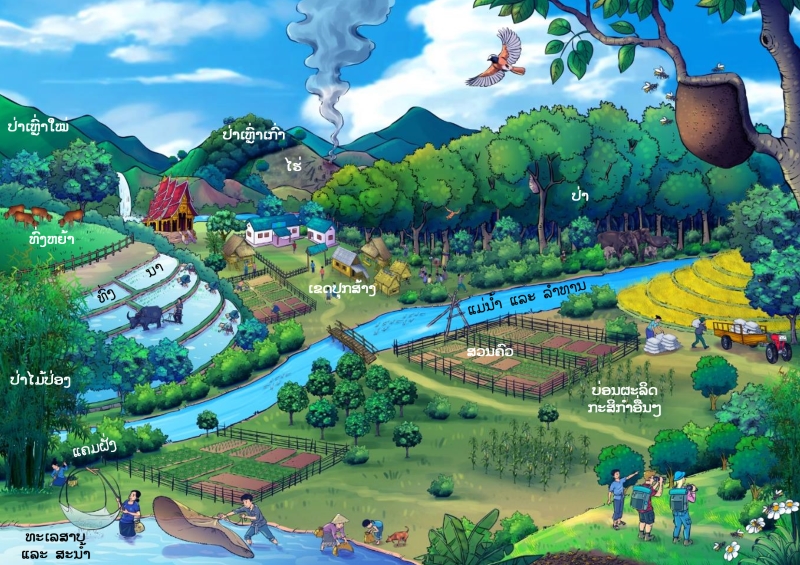
ສະເພາະຖິ່ນໃນລາວ:
ພື້ນເມືອງ
ຮຸກຮານ
:
N/A
ສະຖານະພາບການອະນູຮັກ IUCN
:
ມີຄວາມສ່ຽງໜ້ອຍສຸດ
ສະຖານະພາບການອະນຸຮັກແຫ່ງຊາດລາວ
:
ບັນຊີທີ່ II: ສະນິດພັນປະເພດຄຸ້ມຄອງ
ການນຳໃຊ້
ປະເພດການນຳໃຊ້:
ອາຫານ
ບັນຍາຍການນຳໃຊ້:
ການປູກ ການລ້ຽງ:
ຊະນິດທຳມະຊາດ
ລະດູການເກັບກູ້:
ມັງກອນ
ກຸມພາ
ມີນາ
ທັນວາ
ກຸມພາ
ມີນາ
ທັນວາ
ການຕະຫຼາດ ແລະ ຕ່ອງໂສ້ມູນຄ່າ:
N/A
ການຄຸ້ມຄອງຈັດການ
N/A
ໂພຊະນາການ
ຄຸນຄ່າທາງໂພຊະນາການ:
ບັນຍາຍຄຸນຄ່າທາງໂພຊະນາການ:
N/A
| ສານອາຫານ | /100g | ໝາຍເຫດ |
|---|---|---|
| ໂປຣຕີນ | N/A | N/A |
| ຄາໂບໄຮເດຣດ | N/A | N/A |
| ໄຂມັນ | N/A | N/A |
| ວິຕາມິນ | N/A | N/A |
| ແຮ່ທາດ | N/A | N/A |
| ເສັ້ນໄຍ | N/A | N/A |
ອ້າງອິງ
ເຄດິດຮູບພາບ:
East Asian Porcupine. [1] iNaturalist [Online]. Uploaded on 16 October by Rimba. Available: https://www.inaturalist.org/observations/34443298 [Accessed: 19 August2024]
East Asian Porcupine up close. [2] iNaturalist [Online]. Uploaded on 22 June 2019 by: yuwaree_k. Available: www.inaturalist.org/photos/153272482. [Accessed: 01 October 2024].
East Asian Porcupine. Source. [3] iNaturalist [Online]. Uploaded on 18 December 2018 by: aphidiinae. Available: www.inaturalist.org/photos/214103568. [Accessed: 01 October 2024].
East Asian Porcupine up close. [2] iNaturalist [Online]. Uploaded on 22 June 2019 by: yuwaree_k. Available: www.inaturalist.org/photos/153272482. [Accessed: 01 October 2024].
East Asian Porcupine. Source. [3] iNaturalist [Online]. Uploaded on 18 December 2018 by: aphidiinae. Available: www.inaturalist.org/photos/214103568. [Accessed: 01 October 2024].
ອ້າງອິງ:
[1] iNaturalist [Online]. Uploaded on 16 October by Rimba. Available: https://www.inaturalist.org/observations/34443298 [Accessed: 19.08.2024]
[2] iNaturalist [Online]. Uploaded on 14 June 2023 by Jueming641. Available: https://www.inaturalist.org/observations/167389239 [Avail-able: 19.08.2024]
[3] GBIF [Online]. Uploaded on 04 February 2023 by Kenbehrens. Avail-able: https://www.gbif.org/occurrence/4046242839 [Accessed: 19.08.2024]
[4] D. Prathumtong and A. P. Khlaipet, Mammals of Natural world herit-age “Thung Yai Naresuan – Huai Kha Khaeng”. Pahum Thani: National Science Museum Thailand. 2022
[5] GBIF [Online]. Available: https://www.gbif.org/species/5219890 [Ac-cessed: 20.08.202
[6] W. R. Farida, A. P. Sari, N. Inayah, and H. A. Nguroho,“Observations of behavioral development on common Porcupines (Hystrix brachyura) un-dergoing domestication,” Earth and Environmental Science, vol. :10. pp 1755-1315,2018
[7] IUCN. (2016, September 11). IUCN red list. Retrieved from ICUN red list web site: https://www.iucnredlist.org/species/10749/115099298
[8] ສະພາແຫ່ງຊາດ. (2023) ກົດໝາຍວ່າດ້ວຍສັດປ່າ (ສະບັບປັບປຸງ)
[9] A. L. Johnson, “Wildlife in Lao PDR 2024 status report,” Xaset-tha district, Vientiane capital: Wildlife Conservation Society Lao PDR Program
laos.wcs.org. 2024
[2] iNaturalist [Online]. Uploaded on 14 June 2023 by Jueming641. Available: https://www.inaturalist.org/observations/167389239 [Avail-able: 19.08.2024]
[3] GBIF [Online]. Uploaded on 04 February 2023 by Kenbehrens. Avail-able: https://www.gbif.org/occurrence/4046242839 [Accessed: 19.08.2024]
[4] D. Prathumtong and A. P. Khlaipet, Mammals of Natural world herit-age “Thung Yai Naresuan – Huai Kha Khaeng”. Pahum Thani: National Science Museum Thailand. 2022
[5] GBIF [Online]. Available: https://www.gbif.org/species/5219890 [Ac-cessed: 20.08.202
[6] W. R. Farida, A. P. Sari, N. Inayah, and H. A. Nguroho,“Observations of behavioral development on common Porcupines (Hystrix brachyura) un-dergoing domestication,” Earth and Environmental Science, vol. :10. pp 1755-1315,2018
[7] IUCN. (2016, September 11). IUCN red list. Retrieved from ICUN red list web site: https://www.iucnredlist.org/species/10749/115099298
[8] ສະພາແຫ່ງຊາດ. (2023) ກົດໝາຍວ່າດ້ວຍສັດປ່າ (ສະບັບປັບປຸງ)
[9] A. L. Johnson, “Wildlife in Lao PDR 2024 status report,” Xaset-tha district, Vientiane capital: Wildlife Conservation Society Lao PDR Program
laos.wcs.org. 2024
ຜູ້ສ້າງ Factsheet:
ຜູ້ກວດສອບ Factsheet:
,
